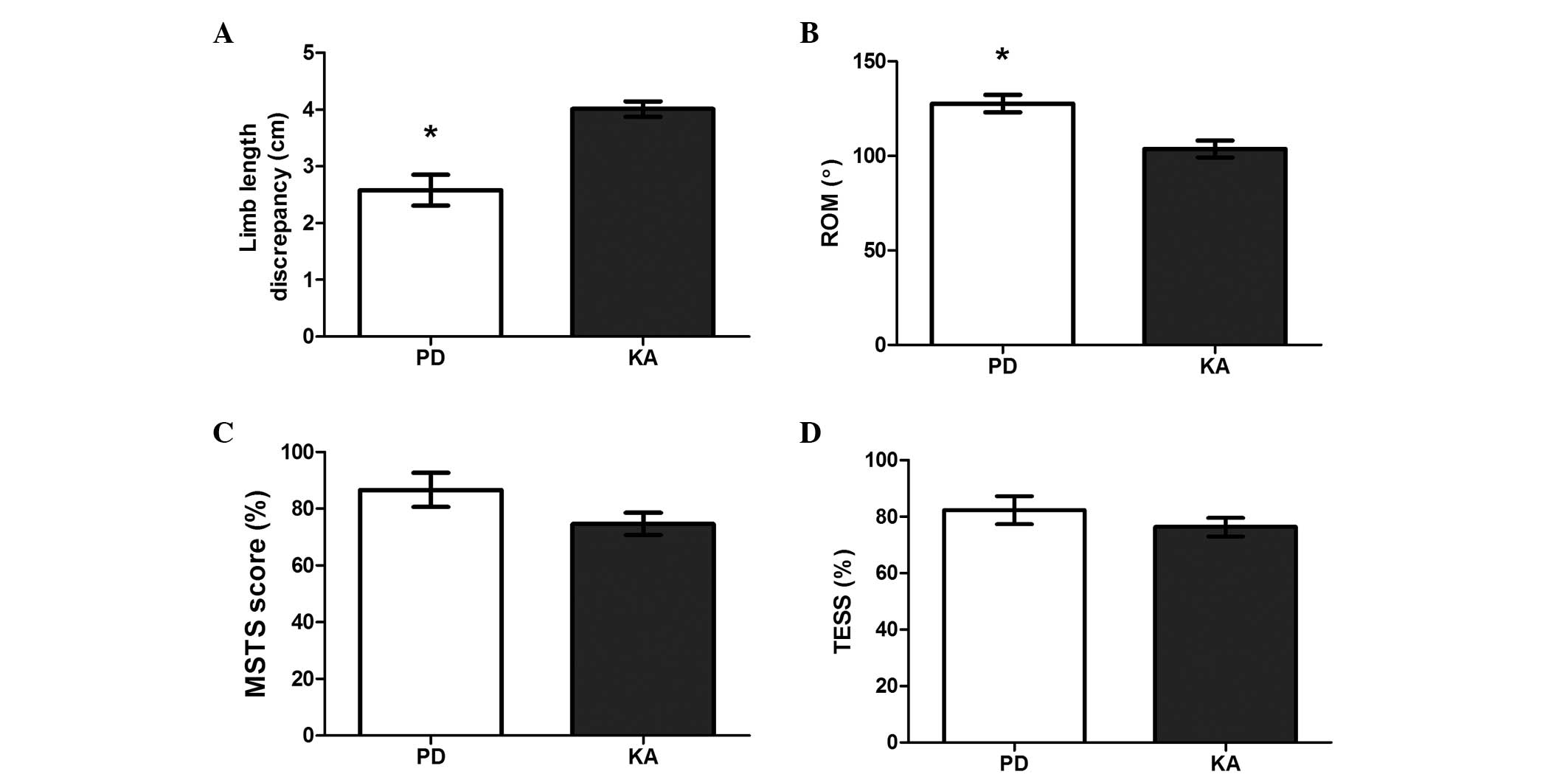|
1
|
Ottaviani G and Jaffe N: The epidemiology
of osteosarcoma. Cancer Treat Res. 152:3–13. 2009. View Article : Google Scholar
|
|
2
|
Ries LAG, Melbert D and Krapcho M: SEER
Cancer Statistics Review, 1975–2004. Bethesda, MD: National Cancer
Institute; 2006, http://seer.cancer.gov/csr/1975_2004/uri.
Accessed September 30, 2013
|
|
3
|
Gurney JG, Swensen AR and Bulterys M:
Malignant bone tumors. Cancer Incidence and Survival Among Children
and Adolescents: United States SEER Program 1975–1995 Bethesda, MD:
National Cancer Institute; 1999, http://seer.cancer.gov/publications/childhood/bone.pdfuri.
Accessed September 30, 2013
|
|
4
|
Betz M, Dumont CE, Fuchs B and Exner GU:
Physeal distraction for joint preservation in malignant metaphyseal
bone tumors in children. Clin Orthop Relat Res. 470:1749–1754.
2012. View Article : Google Scholar : PubMed/NCBI
|
|
5
|
Abudu A, Grimer R, Tillman R and Carter S:
The use of prostheses in skeletally immature patients. Orthop Clin
North Am. 37:75–84. 2006. View Article : Google Scholar : PubMed/NCBI
|
|
6
|
Campanacci L, Manfrini M, Colangeli M, Ali
N and Mercuri M: Long-term results in children with massive bone
osteoarticular allografts of the knee for high-grade osteosarcoma.
J Pediatr Orthop. 30:919–927. 2010. View Article : Google Scholar : PubMed/NCBI
|
|
7
|
Muscolo DL, Ayerza MA, Aponte-Tinao LA and
Ranalletta M: Partial epiphyseal preservation and intercalary
allograft reconstruction in high-grade metaphyseal osteosarcoma of
the knee. J Bone Joint Surg Am. 87(1 Suppl 2): 226–236. 2005.
|
|
8
|
Muscolo DL, Ayerza MA, Aponte-Tinao LA and
Ranalletta M: Use of distal femoral osteoarticular allografts in
limb salvage surgery. Surgical technique. J Bone Joint Surg Am.
88(1 Suppl 2): 305–321. 2006.PubMed/NCBI
|
|
9
|
Cañadell J, Forriol F and Cara JA: Removal
of metaphyseal bone tumours with preservation of the epiphysis.
Physeal distraction before excision. J Bone Joint Surg Br.
76:127–132. 1994.PubMed/NCBI
|
|
10
|
Weitao Y, Qiqing C, Songtao G and Jiaqiang
W: Epiphysis preserving operations for the treatment of lower limb
malignant bone tumors. Eur J Surg Oncol. 38:1165–1170. 2012.
View Article : Google Scholar : PubMed/NCBI
|
|
11
|
El-Gammal TA, El-Sayed A, Kotb MM, Saleh
WR and Ragheb YF: Knee joint reconstruction after hemiarticular
resection using pedicled patella and vascularized fibular graft.
Microsurgery. 30:603–607. 2010. View Article : Google Scholar : PubMed/NCBI
|
|
12
|
D‘Adamo DR: Appraising the current role of
chemotherapy for the treatment of sarcoma. Semin Oncol. 38(Suppl
3): S19–S29. 2011.PubMed/NCBI
|
|
13
|
Enneking WF, Dunham W, Gebhardt MC,
Malawar M and Pritchard DJ: A system for the functional evaluation
of reconstructive procedures after surgical treatment of tumors of
the musculoskeletal system. Clin Orthop Relat Res. 241–246.
1993.
|
|
14
|
Davis AM, Wright JG, Williams JI,
Bombardier C, Griffin A and Bell RS: Development of a measure of
physical function for patients with bone and soft tissue sarcoma.
Qual Life Res. 5:508–516. 1996. View Article : Google Scholar : PubMed/NCBI
|
|
15
|
El Mesbahi O, Arifi S, Benbrahim Z, et al:
A rare case of locally advanced fibrosarcoma of diaphysal humerus
managed successfully with limb-sparing procedures after neoadjuvant
chemotherapy. World J Surg Oncol. 8:772010.PubMed/NCBI
|
|
16
|
San-Julian M, Aquerreta JD, Benito A and
Cañadell J: Indications for epiphyseal preservation in metaphyseal
malignant bone tumors of children: relationship between image
methods and histological findings. J Pediatr Orthop. 19:543–548.
1999. View Article : Google Scholar : PubMed/NCBI
|
|
17
|
Bou Sleiman H, Ritacco LE, Aponte-Tinao L,
Muscolo DL, Nolte LP and Reyes M: Allograft selection for
transepiphyseal tumor resection around the knee using
three-dimensional surface registration. Ann Biomed Eng.
39:1720–1727. 2011.PubMed/NCBI
|
|
18
|
Langlois V and Laville JM: Physeal
distraction for limb length discrepancy and angular deformity. Rev
Chir Orthop Reparatrice Appar Mot. 91:199–207. 2005.(In
French).
|
|
19
|
De Bastiani G, Aldegheri R, Renzi Brivio L
and Trivella G: Limb lengthening by distraction of the epiphyseal
plate. A comparison of two techniques in the rabbit. J Bone Joint
Surg Br. 68:545–549. 1986.PubMed/NCBI
|
|
20
|
Pereira BP, Cavanagh SP and Pho RW:
Longitudinal growth rate following slow physeal distraction. The
proximal tibial growth plate studied in rabbits. Acta Orthop Scand.
68:262–268. 1997. View Article : Google Scholar : PubMed/NCBI
|
|
21
|
Fang B, Yi C, Zhang H, et al: Combined
epiphyseal preservation and autograft bone transfer in treatment of
children osteosarcoma. Zhongguo Xiu Fu Chong Jian Wai Ke Za Zhi.
27:45–49. 2013.(In Chinese).
|
|
22
|
Aksnes LH, Bauer HC, Jebsen NL, et al:
Limb-sparing surgery preserves more function than amputation: a
Scandinavian sarcoma group study of 118 patients. J Bone Joint Surg
Br. 90:786–794. 2008. View Article : Google Scholar : PubMed/NCBI
|
|
23
|
Niimi R, Matsumine A, Hamaguchi T,
Nakamura T, Uchida A and Sudo A: Prosthetic limb salvage surgery
for bone and soft tissue tumors around the knee. Oncol Rep.
28:1984–1990. 2012.PubMed/NCBI
|












